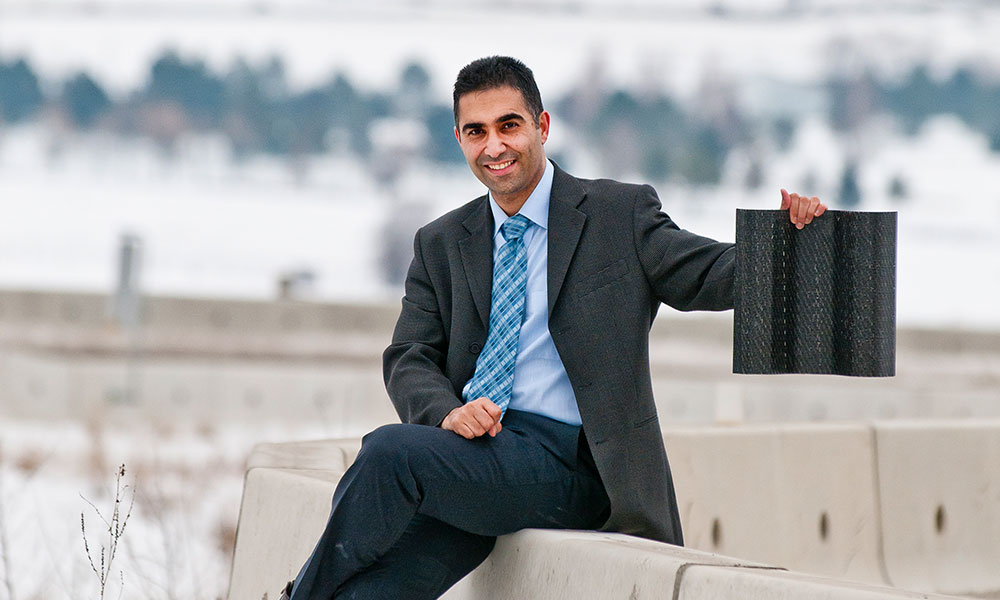Faculty Profile, People
Filling the gap between industry and university
May 29, 2017

About
Name
Abbas Milani
Role
Professor
Program
Mechanical Engineering
School
Engineering
Faculty
Applied Science
Campus
Okanagan (Kelowna, BC)
Education
PhD, Mechanical Engineering (McGill)
MSc, Mechanical Engineering (IUST)
BSc, Mechanical Engineering (IUST)
Hometown
Montreal, Quebec
Tehran, Iran
“There is a gap between the ‘know why’ and the ‘know how.’ The university knows why and the industry knows how—these two need to be linked. We can help each other!”
PROFESSOR ABBAS MILANI researches advanced composite materials due to their superior physical, thermal, and mechanical properties for performance-based design. Lightweight and flexible, they can be found in aerospace, sports equipment, boats, and home appliances, to name a few.
Milani’s engineering students are involved in materials testing through the pan-western Composites Research Network (CRN).
The whole knowledge of composites is divided into Knowledge in Practice Documents (KPDs): foundational KPDs; then theme-level KPDs; then workflow KPDs; and then case studies KPDs.
Most of the students work in the first two: foundational and thematic levels. Industry cooperates to assist students in the workflow and case studies.
“It’s a systematic umbrella,” Milani says. “This is how the gap between industry and university is being filled at UBC Okanagan. The categorization of the system is unique to CRN.”
UNIVERSITY + INDUSTRY
Fibreglass and carbon fibres are the most-known and most-used composite textiles in industry, Milani says.
“They’ve been used for the past few decades—but not perfectly. The processing still has a lot of unknowns—question marks. That is where the university and industry should be linked to each other: the industry processes the materials whereas the university is doing testing and modelling at the material scale.
“There is a gap between the ‘know why’ and the ‘know how.’ The university knows why and the industry knows how—these two need to be linked. We can help each other!”
In this field, Milani says, you cannot trace problems back to a particular point in the process: “You have to know the whole story. If anything goes wrong, you have to know everything behind the composites to solve the problem. This makes it fascinating for a researcher.
“It is not a unilateral field—it is completely multilateral. You have to know materials sciences of composites, manufacturing of composites, as well as design and optimization of composites.”
MYSTERIES FOR RESEARCHERS
Manufacturers still face uncertainty and risk in making new products with optimized structural performances. “It’s a challenge to process these materials so there are no defects,” says Milani. “Their processing can be scientifically complex; there are a lot of mysteries for researchers. The variations of properties of these new materials are yet to be completely known—they can differ greatly between the beginning and final stages of processing.”
Given the novelty and cost-effectiveness of composite materials, several industries are starting to implement them in their manufacturing processes, without full consideration of the sustainability impact. This leads to another component of Milani’s research, which is concerned with the life-cycle of composites—from material, to manufacturing, to service, to disposal.
“We are trying to see if we can make some composites more recyclable or reusable,” says Milani, whose research explores the potential of thermoplastic natural-fibre composites that are more environmentally friendly.
NETWORK OF PARTNERSHIPS

Milani has worked with more than 100 universities and industrial partners to employ state-of-the-art modeling and experimental research tools in his lab in a range of projects in transportation, construction, automotive, and aerospace.
He also leads the Okanagan Node of the CRN, as well as the Advanced Materials and Fabrication theme within UBC’s Survive and Thrive Applied Research (STAR). The STAR initiative exemplifies UBC’s spirit of innovation with cutting-edge projects; it brings to market technologies for human protection and performance in extreme, remote, or rural conditions.
The CRN is a Canadian research network founded by Western Economic Diversification to assist the Canadian composites manufacturing sector in developing the necessary skills and expertise to compete for new opportunities in the rapidly expanding global composites market.
“The Okanagan is becoming a hotbed for these composites,” Milani says. “Over 40 companies are working with composites in the Okanagan. Some senior National Research Council (NRC) members have suggested they want to further invest in the West, and keep connections with us so that they can create new joint projects, nationwide. This will link industry, west and east. UBC Okanagan has a significant role.”
Milani was recently awarded the prestigious UBC Killam Research Fellowship, which enabled him to pursue full-time research at MIT.